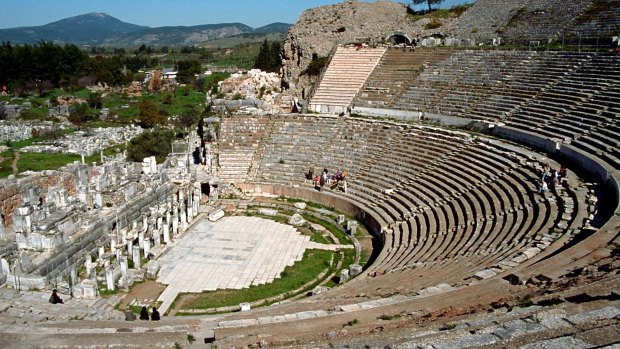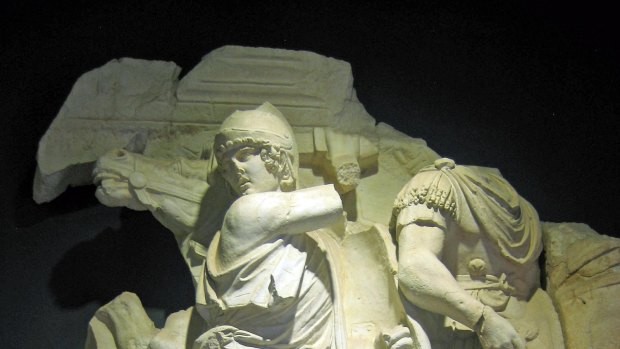This was published 7 years ago
Shore excursion with Silversea: A guided tour of Ephesus, Turkey

The Great Theatre at Ephesus.Credit: Brian Johnston
Like most cruisers, I set aside a budget for shore excursions, and a $250 price tag for a single tour makes me dither. After all, I can visit Ephesus on Silversea's included shore excursion at no extra cost, and I've been to Ephesus twice before. But this shore excursion promises something different: an in-depth visit to the ruined city with Genghis Icten, former Ephesus Museum director and, for 40 years, one of its chief archaeologists.
I know the value of expert guides, not least at archaeological sites, where the skeletons of temples are best fleshed out by explanation and background. This is a rare opportunity to talk to someone who knows Ephesus intimately, and so I find myself disembarking Silver Spirit lighter of wallet but with high expectations.
Our first stop is the Ephesus Museum in Selçuk, the modern town adjacent to the ruins. Genghis is there to greet us: a short, rotund man in rimless glasses and a peppered beard, trousers held up by braces. He radiates enthusiasm, and right away I know I've made the right decision. Good guides are as rare as a golden fleece.

This relief on the Parthian monument from the second century AD is just one of the wonders at the absorbing Ephesus Museum.Credit: Brian Johnston
The Ephesus Museum has recently reopened after a three-year renovation and, though Genghis has retired as its director, his team dug up many of its exhibits: the bust of a Roman emperor, medical instruments, a medieval piggy bank whose 25 silver coins Genghis himself saw sparkling in the soil. He says he especially liked surveying the valley between harbour and river. "We found a Neolithic settlement from 7000BC which completely altered our time scale for Ephesus, which is now being excavated by specialists in that period."
Genghis is a classical archaeologist with a focus on the Greek and Roman eras, and there seems little he doesn't know about his subject. He talks of changing preservation methods, showing us marble fixed together with 1960s iron bleeding rust; copper and fibreglass are now the materials of choice. He explains how we can determine a bust is of the empress Livia by comparing its features to the profiles on named coins. As for coins, Ephesus coins depict bees. "The wings became closer to the bodies over the centuries, so that's a good way of pinning down the date of an excavation," he says. "Lost coins are scattered everywhere in the ruins."
The former museum director hobbles around like a wizard, leaning on a walking stick and clearly proud of his achievements. Many statues have been removed from behind glass and displayed on pedestals, allowing wonderfully close-up, 360-degree inspections. "You see here?" Genghis explains. "This statue has an idealised Greek face. But see this bust? This is an actual Roman face, much more realistic. Though it seems there was something wrong with this fellow, he looks as if he needs antacids."
Sometimes I think the twinkle-eyed Genghis is pulling our legs, especially when he suggests a close-up inspection of the shapely buttocks of a Dionysus statue. "You can make out two measuring dots left behind by the sculptor, surely by mistake. It's very unusual to see those, but it helps us work out how Greek sculptors achieved proportion."
Our small group is rather mesmerised by Genghis, and we could possibly have lingered far longer in the museum. Eventually, though, we head off to put the treasures into the context of the ancient city up the road. We start near the ruined Odeon, a small theatre once dedicated to musical events, where stray cats loll on sun-warmed marble. From here, Curetes Street leads downhill into the heart of Ephesus, flanked by triumphal arches and headless statues. Fallen pedestals and pillars lie in a jumble, many carved with grape leaves or geometric flourishes. The Temple of Hadrian features a bare-breasted Amazon carved among swirling stone flowers.
Nearby are the public baths, with their row of marble latrines. "Slaves had the task of warming the stone seats for their masters," Genghis says. 'It was normal to discuss business as you did your business. It was a networking opportunity, with adjacent baths and rooms for relaxation." He mentions that Emperor Vespasian introduced a toilet tax after bankrupting the state to build the Colosseum in Rome, and that public urinals in Italy are still called vespasiani.
At its height, Ephesus had a population of 250,000, and was the capital of Rome's Asian provinces. Trading in slaves, wool, wine, olive oil, silk and perfumes, it became one of the wealthiest cities in the Greco-Roman world and saw a building boom. The now-lost Temple of Artemis, four times larger than the Parthenon, was one of the Seven Wonders of the World. Still preserved is the 25,000-seat Great Theatre, a sprawling agora and, most famously, an elaborate statue-decorated library.
Ephesus' richest merchants lived in impressive style. In the Ephesus Museum we see ivory friezes, a bronze statue of Eros on a dolphin, boxes of jewellery and a sixth-century BC Egyptian statue that shows the second-century Romans were keen art collectors. Now we enter the Terrace Houses, the first of which belonged to nouveau-riche Gaius Flavius Foreus Aptius. It's as vast as a Shanghai penthouse, with an onyx fountain in the vestibule, steam heating, plumbed bathrooms and 35 kinds of marble inlaid into its floors and walls.
The Terrace Houses are built into the slope of the hill off Curetes Way, one on top of the other like luxury beach condos. They date from the first century, but many were used until the seventh century. Most are two storeys, built around a courtyard, decorated with stuccowork, marble and fabulously preserved mosaics, and once topped by red roofs. (They're now covered by a $15-million Teflon marquee.) Only seven villas have been excavated to date, but the hillside behind conceals many more. "We've been working here for 120 years and only excavated about a tenth of the site. We're lucky as archaeologists, we'll have jobs for another 300 years," says a gleeful Genghis.
Eventually, the owners of these villas ended up in the elaborate marble sarcophagi we inspected earlier in the museum. One was found by Genghis in 1978, and he points to the two letters zeta and ash which show that the owner was still alive when the sarcophagus was commissioned. "Obviously she had money, it took a master craftsman a year to make such an object. But not so whoever came after, it seems this sarcophagus was reused, you can see these inscriptions were added in the Christian era."
Another sarcophagus is the last treasure Genghis excavated before he retired in 2006. It's beautifully sculpted with cupids, garlands of fruit and a portrait of its former occupant. "Get down low and look at his face, it's fantastic," Genghis says. "That's a real Roman, and his family must have cried for him.
"The first time as a young archaeologist that I found a skeleton I was a bit spooked, but after maybe 2000 you get used to it. Somebody, some day, may touch my bones and tell a story, wouldn't that be wonderful?"
Such is the retired archaeologist's enthusiasm that I think yes, it would. And maybe someone will be lucky enough to be on a cruise, and sail in to learn about it all, and that would be wonderful, too.
TRIP NOTES
MORE INFORMATION
GETTING THERE
Emirates flies from Sydney and Melbourne to Dubai (14.5 hours) with onward connections to both Istanbul and Athens (4.5 hours). Phone 1300 303 777, see emirates.com/au
CRUISING THERE
Silversea's nine-day "Istanbul to Piraeus" itinerary is priced from $6250pp twin share, including meals, beverages, Wi-Fi and gratuities, and has both included and paid shore excursions. "Ephesus & Terrace Houses with an Archaeological Expert" costs $US179 ($250) per person. Phone 1300 306 872, see silversea.com.
Brian Johnston travelled as a guest of Silversea.
FIVE MORE EXCURSIONS INTO HISTORY
Five other guided shore excursions on Silversea's cruise through Turkey and Greece contribute to a fascinating sail through the centuries.
PERGAMUM & ASKELPION
Dikili port is the gateway to Pergamum, whose ruined palaces and temples sit atop a rocky crag; a well-preserved Greek theatre wedged into the rock is magnificent. Down below lies the famed medical centre Asklepion, where wealthy Romans came to drink mineral waters and receive psychiatric treatments.
ST JOHN'S PATMOS & THE MONASTERY
The Greek island of Patmos is reputedly the spot where St John received the Revelation; the cave where he wrote the Apocalypse has been converted into a chapel. The tour also visits the Monastery of St John the Theologian, notable for its decorated arches and pebble-pattern floors.
MEDIEVAL RHODES
The old town of Rhodes, on the Greek island of the same name, is World Heritage listed for its ancient churches, Turkish houses and crusader-era fortifications and castle. The tour visits the palace of the Knights of Rhodes, the old town, and the archaeological museum with its exquisite marble Aphrodite statue.
SACRED ISLAND OF DELOS
This small island off Mykonos is scattered with the ruins of an important ancient Greek cultural and religious centre. You can trace the remains of the stadium, theatre, mosaic-adorned villas and various sanctuaries and temples, all in blinding white marble; five marble lions stand silent sentinels to the ages.
ACROPOLIS & SCENIC DRIVE OF ATHENS
The Acropolis boasts not just the Parthenon but several masterpieces of classic architecture, including the entranceway Propylaea and statue-studded Erechtheion temple. Magnificent views unfold to the sea and mountains. A city drive later takes you past other notable ancient ruins and Athens' contemporary sights.
Sign up for the Traveller Deals newsletter
Get exclusive travel deals delivered straight to your inbox. Sign up now.